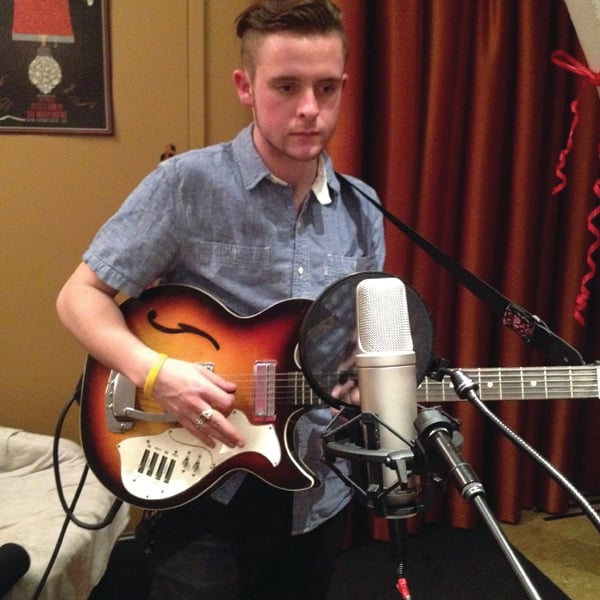With so many models to choose from, what should you look for in picking your next microphone? We like to think of picking a microphone like picking a car. First jot down what features are you looking for – do you need 4-wheel drive? Do you need good gas mileage? Or in our case, what is this microphone for? Will it be dedicated to recording kick drums at live gigs? Will it be recording a guitar rig? Will it just be living in a studio environment or will it have to handle the abuses of live gigs and rehearsals? What’s your budget? Okay so here’s a jumping off point with some of our picks for mics that work well in the following cases. Be sure to catch up on Performer’s Ultimate Guide to Microphone Selection Part 1 right here.
DRUMS
Kick drums are a special kind of instrument that put out incredible amounts of sound pressure waves and to make them sound good they require a specialized microphone. You will almost always want a dynamic mic because of this. Our recommendation after years of trying many different mics is that you can’t really go wrong with the AKG D112. This weird-looking, egg-shaped microphone has never let us down and retails for about $250. There are others that work well too, like the Shure Beta 52 ($240) and Audix D6 ($300) and some opt for the large dedicated Yamaha SKRM-100 SubKick ($600) to help capture the really low end of the instrument.
The snare puts out a crack that requires a fast moving dynamic coil to capture its sonic qualities. The tried and true, which has recorded more snare drums than any other, is luckily very affordable and rugged – the Shure SM57 ($100). The nice thing about the SM57 is that it is also equally at home recording hi-hat, guitar rigs and even vocals. Some producers like the sound of a large capsule condenser mic placed a few feet above a snare drum to capture more of the “air” – for this purpose you could use an AKG C414 ($1,200) or the AKG C214 ($400) for a similar sound on a budget.
Toms offer a challenge, in that generally you would like to use a smaller mic that can attach easily to the drum without the need for many large mic stands getting in the way. The Audix D2 and D4 ($140) are small and can mount on a rim-mounted mic clip to save space. The venerable (and large) Sennheiser MD421 dynamic mic ($400) sounds great but can be a bit pricey and harder to maneuver on tight drum sets.
CYMBALS & DRUM ROOM
We have had good luck capturing drum rooms and cymbals with a matching pair (stereo) of small diaphragm condenser mics like the stereo Rode NT-4 ($600) or a pair of AKG Perception 170’s ($100) each.
GUITARS
The SM57 is again the fallback to close mic an electric guitar rig, but often we’ll use the Sennheiser e609 ($125). Acoustic guitars have many options depending on the style and sound of the guitar; our fallback stereo setup might be a pencil (small diaphragm condenser) mic near the neck like the Audio Technica AT4041 ($300) and a large diaphragm condenser near the sound hole like the AKG-C3000 ($400).
STRINGS
Strings have subtleties that are captured well by large diaphragm condenser mics. On a super tight budget but still want a large diaphragm condenser mic? The MXL 990 ($125) comes with a shock mount and sounds surprisingly good for the price.
HORNS
Brass and horns can put out quite a bit of sound pressure when mic’ed up close, so in the studio we favor dynamics like the EV N/D468 ($225) for those situations. Horn players also move around a lot so if you are talking live gigs you should seriously look into mics like the AMT LSW ($550) which clip right onto the instrument and feature an integrated shock mount. A great all around mid-size capsule condenser mic that works well for room mic’ing horns and many other instruments is the Blue Spark ($225).
VOCALS
Vocals have so many characteristics that trying to recommend just one or two mics is bound to get us into trouble, but suffice it to say that a great place to start is a large diaphragm condenser mic like the Rode NT-1A ($300) or the Blue Baby Bottle ($400). Make sure to always use a pop filter and we also recommend an isolator (like the Auralex Mudguard) behind the mic to cut down on room noise.
CLOSING THOUGHTS
A good mic cabinet has mics that cover all the bases and it can take years to collect. So when you’re starting out, we recommend that you look for some versatile mics that can handle many situations well. Then start adding mics for specific purposes (like kick drums). Whenever possible, use shock mounts and pop-filters for singers. Read reviews and talk to peers to find those mics that offer the best bang for the buck.
ABOUT THE AUTHORS
Zac Cataldo is a musician and owner/producer at Night Train Studios, a recording studio in Westford, MA. He is also co-owner of Black Cloud Productions, a music publishing company. Reach him at zac@nighttrainstudios.com.
Brent Godin is a bassist/guitarist and engineer/producer at Night Train Studios. He is also a talent scout at Black Cloud Productions. Reach him at brent@blackcloudproductions.com.
